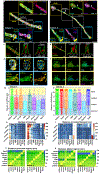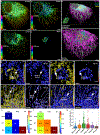Unraveling cellular complexity with transient adapters in highly multiplexed super-resolution imaging
- PMID: 38552613
- PMCID: PMC12135969
- DOI: 10.1016/j.cell.2024.02.033
Unraveling cellular complexity with transient adapters in highly multiplexed super-resolution imaging
Abstract
Mapping the intricate spatial relationships between the many different molecules inside a cell is essential to understanding cellular functions in all their complexity. Super-resolution fluorescence microscopy offers the required spatial resolution but struggles to reveal more than four different targets simultaneously. Exchanging labels in subsequent imaging rounds for multiplexed imaging extends this number but is limited by its low throughput. Here, we present a method for rapid multiplexed super-resolution microscopy that can, in principle, be applied to a nearly unlimited number of molecular targets by leveraging fluorogenic labeling in conjunction with transient adapter-mediated switching for high-throughput DNA-PAINT (FLASH-PAINT). We demonstrate the versatility of FLASH-PAINT with four applications: mapping nine proteins in a single mammalian cell, elucidating the functional organization of primary cilia by nine-target imaging, revealing the changes in proximity of thirteen different targets in unperturbed and dissociated Golgi stacks, and investigating and quantifying inter-organelle contacts at 3D super-resolution.
Keywords: DNA-PAINT; FLASH-PAINT; multiplexing; nanoscopy; spatial omics; super-resolution.
Copyright © 2024 Elsevier Inc. All rights reserved.
Conflict of interest statement
Declaration of interests F.S. and J.B. filed patent applications with the U.S. patent office covering the conceptional ideas of this study. J.B. has licensed IP to Bruker Corp. and Hamamatsu Photonics. J.B. is a consultant for Bruker Corp. J.B. is a founder of panluminate, Inc.
Figures







References
MeSH terms
Substances
Grants and funding
LinkOut - more resources
Full Text Sources

